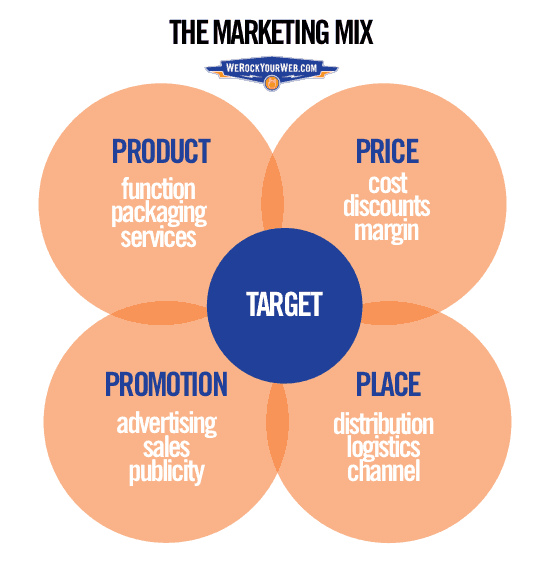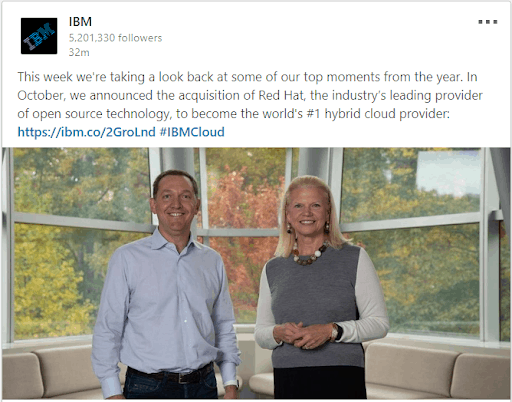“In marketing, I’ve seen only one strategy that can’t miss – to market to your best customers first.” – John Romero
Efficient and effective marketing strategies are one of the most sought out assets for every company. Terms like “ROI” and “marketing funnel” get thrown around, but truthfully, customers care about the end result: what is making them money?

The marketing mix was a concept created by experts to resolve the issue above; however, over the years it has gone from 4 P’s (words that start with P) to as many as 12 P’s, depending on your conceptual view of marketing.
Today, I will focus on the eight most applicable aspects of the B2B space: price, product, promotion, place, purpose, people, perception, and process.
What are the 4 P’s of Marketing?
The traditional marketing mix is what most marketing professionals have referenced over the past 65 years and considered the framework for business growth.
The popular term for this is the 4 Ps of Marketing, which includes price, product, promotion, and place.
Whether it be product development or the formation of a new company, these concepts are utilized in bringing a new product or service to market.

With the latest advancement of marketing technologies and increased ability to reach customers via the internet and social media, there have been additional P’s added to the mix.
Depending on the marketer, the number of specific “P’s” changes. Today, purpose, people, process, and perception seem to be the most applicable, especially to the B2B space. In the educational space, the traditional marketing mix is still discussed as the main attributes for marketing strategy.
The Traditional 4 P’s of Marketing
Price
How much does it cost?
The price in the marketing mix defines what value is placed on the product or service provided.
The way this is determined is by examining the individual value of the product or service, observing established price points in the industry, and doing a competitive analysis to determine at which price point the product or service can be competitive at.
Make sure you are doing a lot of research before you determine your price point!

Depending on the time of the year, discounting the initial launch of the product or service may be a good idea to attract customers to your company. In the B2B space, discounts may take the shape of a free trial or demo. This gives the customer an opportunity to see how useful the product or service is before the purchase.
However, be aware of your customer climate. If you offer discounts right away, your product or service may come off as cheap! Be strategic.
Product
What is your product? How is it different from everything else out there?
This may seem intuitive at first, but many factors need to be considered when thinking about a new product or service. For example, the branding, size, and color are all critical physical attributes that the customer thinks about when purchasing a physical product.
It’s crucial to know in advance how you want to market your product, ensure quality is a priority and made with your target audience in mind.
In the B2B space, branding is imperative. Businesses want to connect on more than just the transaction, and brand is the way to achieve this.
If there is a lack of content being pushed by the company, it is challenging for companies to connect on more than just a sales level. It takes blood, sweat, and tears to create a reliable brand. Think Coca-Cola. Think Nike. Think Apple.
These colossal brands did not come into play overnight.
Putting the customer first is one of the more crucial aspects that need to be considered if you want to leave your mark. Ask a lot of questions about the product to ensure you are reaching the correct customer.
What features will the customer appreciate? How will the customer use my product? What does the customer even want???
Think about a big B2B player like Salesforce. They are one of the biggest brands in the B2B space, primarily known for their storytelling and highlighting client success.
Salesforce has also been known for being innovative, not only in the way they tweak their top of the line CRM, but they way they target their audience as well.
By creating an environment where storytelling is the norm, they humanistically connect with their customers. This is important because Salesforce genuinely wants their product to work for their customers.
Step back and analyze if your product or service will actually benefit your target audience and make them want to come back.
Promotion
How do you promote the product or service to the customer?
With most media outlets headed in the digital direction, the ways companies are promoting their products and services have transformed.
Promotion used to be limited to TV ads, billboards, radio, and good ol’ word of mouth. While these aren’t super cost effective compared to modernized promotional activities, they got the job done for what was available.
With the boom of the internet and social media, there are new platforms for product and service promotion. Although the majority of these can be utilized across both B2B and B2C spaces, the B2B space uses search engine marketing platforms and practices, including Google Ads, Bing Ads, search engine and conversion rate optimization, and content marketing.
These platforms and practices have been adopted across the B2B space and continue to show high measures of success for many.
Place
How and where do customers access your product or service?
The placement of your product or service is paramount because if placed in the wrong spot, your target customer may never even see it!
With that being said, it’s critical to put the product in front of the customer most effectively and efficiently to maximize your return.
Depending on the size and bandwidth of your company, the majority of companies in B2B have a sales team, or they attend relevant trade shows throughout the year. In short, you need to get out there and…

The traditional 4 P’s have been in the marketing curriculum for a long time, as this has been the backbone of the craft for almost 65 years.
Professional marketers, however, have shown discretion on discussing this marketing mix because, as technology has progressed, new concepts and tactics have been developed to shape marketing as we currently know it.
Evolution of the 4 P’s of Marketing: 4 New P’s
Previously, the traditional marketing mix was solidified by the entire industry, and there were many discrepancies on which of the “new P’s” were attributable to the industry.
However, with the ability to create unique marketing strategies for specific clients and companies, there is no real solidified new “4 P’s”.
In the B2B space, we live by the following “new P’s,” which have helped companies grow their businesses at scale.
Process
“Trust the process” is more than a common phrase amongst Philadelphia 76ers fans and players alike in the NBA. You may ask: “Well, what does that kind of process have to do with B2B business growth?” The answer is simple.
Each NBA team runs their business similar to leaders in the B2B space. Each team has a group of players they have placed a value on where they can increase sales through team development that eventually helps win games.
However, winning games takes time, grit, and strategy.

Let’s bring it back into the B2B space. The team is a company looking to win a championship; in this case, become the best company in their niche. To do that, they must develop their brand, their employees, and their business strategy as they grow.
This growth takes time; however, the most crucial part of this “process” (there it is) is the company’s patience and ability to continually re-evaluate and move pieces until they reach their success metric.
Now, why is this important, and why is it in the “marketing mix”?
In the digital age, brand development is one of the essential aspects of marketing. Customers want to interact and be comfortable with the brand they’re purchasing from.
Being able to observe the hard work the company has done to tell a story about them (which we will go into when we talk about perception) is attractive because it creates this comfortability with the “process.”
Purpose
“Efforts and courage are not enough without purpose and direction.” – John F. Kennedy
It is basically 2019, and we are living in a world where millennials and Gen Z run the social media landscape. With marketing strategies heavily focused on social media, understanding consumer behavior for these generations is necessary to gain traction.
One attribute that is consistent for these generations is they want to have a purpose in what they do, purpose in how they feel day-to-day, and purpose in the friendships and relationships they hold so dearly. It is essential to them as they make decisions.
One undervalued concept is the power of asking why. Whether it be why a company is utilizing specific branding techniques or even asking why they are in the business they are in, you need to understand the company’s intent behind what they do.
With this knowledge, it allows you to target the right audiences, segment the market efficiently, and ultimately build successful campaigns that will provide quality results (kudos to you).
Think about a company like IBM. IBM used to be an industry leader in software, and after a recent shift in the industry, they have focused on humanizing their company through storytelling on social media.

They can relate to users, and have been doing so successfully for several years, which propelled them to the forefront of the B2B space. By providing a purpose for their target audience to relate to, they can relate back with great success.
People
“When leaders throughout an organization take an active, genuine interest in the people they manage when they invest real time to understand employees at a fundamental level, they create a climate for greater morale, loyalty, and, yes, growth.” – Patrick Lencioni
What is a company without its team? Especially in 2018, the focus on companies having work-life balance, taking time for self-care and allowing employees to work remote have shown the desire to retain top talent.
With this in mind, putting the people of your company in front of your clients, you ensure your people will be doing better work because they have time to fill their own cups first. Over time, this will naturally breed quality employees and quality work for clients.
Another important aspect of the people is being able to give them a voice. By providing your team, rather than just the CEO, the opportunity to speak as experts on their craft, they can discuss directly with clients their thoughts on the industry.
Some of the best ways to do this are by creating fresh blog posts, guest posting for other top media outlets, and producing quality videos.
Additionally, the advancement of video changed the digital marketing game. Instead of having to read a boring blog or whitepaper, you can see the person who is speaking, as well as the passion in words through their voice, animated images and more.
Perception
“The difference between average people and achieving people is their perception of and response to failure.” – John C. Maxwell
Customer perception is crucial but, for your company to be perceived in a positive light in the industry, you must effectively apply the other P’s of the marketing mix correctly.
The products or services must be promoted at the right price and placed strategically.
Your process must be efficient, effective, and targeted to the proper segment. Your employees must be thought leaders and show the company has a purpose that is relatable to the customer.
Why? By correctly applying the P’s, your perception will be highly revered by the customer. Giving the customer the ability to become aware of everything your company activates through unlimited transparency will create trust unlike other companies in your industry.
For example, customers want to see that you bring a humanistic approach not only to your work but to your employees as well. Services for your employees, such as in-house therapists, have proven to be extremely attractive because it shows your audience you genuinely care about people.
Creating the perception that your company is filled with real people, and people that you know care about you, can make your company a lot more attractive to future customers.
See below an example of the care partners recently partnered with Directive:

Summary
“It’s fascinating how the fundamentals of business-to-business marketing are the same today as they were 50 years ago. It’s still about relationships although today we have new tools and techniques at our disposal.” – David Meerman Scott
In the B2B space, there are challenges in creating an elaborate marketing strategy and being able to map out “8 P’s.” You must decide on what is essential to your business’s success long-term.
With a growing list of marketing tools providing data at the palm of your hand, there is no excuse why you shouldn’t always be analyzing your business’s marketing efforts and updating to fit the digital landscape.
If anything, use these 8 P’s as a guideline to maximize the analysis of those efforts.
Ultimately, the traditional marketing mix is going to get the job done if you correctly place your product, efficiently promote it, and optimize the price point. But, do you want just to get the job done, or do you want your business to thrive?
By analyzing the processes and purpose of the business, you’ll find quality employees to fulfill your goals and maximize the optimization of your process. The perception of your company will flourish, and you will be able to grow your company effectively.
-
 CEO
Garrett Mehrguth
CEO
Garrett Mehrguth
Did you enjoy this article?
Share it with someone!
